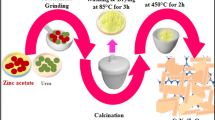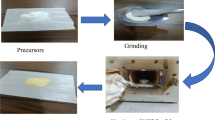Abstract
Cleaving the abundant β-O-4 linkages in lignin is a key issue for producing value-added products by controlled lignin depolymerization. Herein, hydrothermally synthesized In2S3 nanoparticles were primarily used to photodegrade guaiacylglycerol-β-guaiacyl ether, a β-O-4 lignin model compound, under visible light irradiation. The as-synthesized In2S3 nanoparticles are found to be typical β-In2S3 nanocrystals of cubic phase and composed of large plate-like particles and small granular particles by using X-ray diffraction technique and field-emission scanning electron microscopy. The bandgap energy of the In2S3 nanoparticles is estimated to be 1.78 eV using an UV-visible diffuse reflectance spectroscopy. The photodegradation and structure variation of lignin model compound were evaluated by the variation of its UV-vis absorption spectrum, Fourier transform infrared spectrum, and X-ray photoelectron spectroscopy, while its degradation products were identified by using the gas chromatography-mass spectrometry. The results show that the as-synthesized In2S3 nanoparticles can photocatalytically break the β-O-4 linkage and oxidize the hydroxyl/methoxyl groups of lignin model compound under visible light irradiation although the lignin model compound is photo-resistant even under UV irradiation. The photodegradation products of lignin model compound consist of various aromatic monomers including value-added acetovanillone, vanillin, and coniferyl aldehyde. A possible pathway is proposed for photodegrading lignin model compound in the presence of the as-synthesized In2S3 nanoparticles under visible light irradiation.






Similar content being viewed by others
References
Kim KH, Simmons BA, Singh S (2017) Catalytic transfer hydrogenolysis of ionic liquid processed biorefinery lignin to phenolic compounds. Green Chem 19(1):215–224. https://doi.org/10.1039/C6GC02473D
Nair V, Dhara P, Vinu R (2016) Production of phenolics via photocatalysis of ball milled lignin–TiO2 mixtures in aqueous suspension. RSC Adv 6(22):18204–18216. https://doi.org/10.1039/C5RA25954A
Chen Y, Wang F, Jia Y, Yang N, Zhang X (2017) One-step ethanolysis of lignin into small-molecular aromatic hydrocarbons over nano-SiC catalyst. Bioresour Technol 226:145–149. https://doi.org/10.1016/j.biortech.2016.12.008
Chen Z, Wan C (2017) Biological valorization strategies for converting lignin into fuels and chemicals. Renew Sust Energ Rev 73:610–621. https://doi.org/10.1016/j.rser.2017.01.166
Shen XJ, Wen JL, Huang PL, Zheng K, Wang SF, Liu QY, Charlton A, Sun RC (2017) Efficient and product-controlled depolymerization of lignin oriented by Raney Ni cooperated with Cs x H3 −x PW12O40. Bioenerg Res 10(4):1155–1162. https://doi.org/10.1007/s12155-017-9855-2
Biannic B, Bozell JJ (2013) Efficient cobalt-catalyzed oxidative conversion of lignin models to benzoquinones. Org Lett 15(11):2730–2733. https://doi.org/10.1021/ol401065r
Azarpira A, Ralph J, Lu F (2014) Catalytic alkaline oxidation of lignin and its model compounds: a pathway to aromatic biochemical. Bioenerg Res 7(1):78–86. https://doi.org/10.1007/s12155-013-9348-x
Mu W, Ben H, Ragauskas A, Deng Y (2013) Lignin pyrolysis components and upgrading—technology review. 6(4): 1183–1204
Melligan F, Hayes MHB, Kwapinski W, Leahy JJ (2012) Hydro-pyrolysis of biomass and online catalytic vapor upgrading with Ni-ZSM-5 and Ni-MCM-41. Energy Fuel 26(10):6080–6090. https://doi.org/10.1021/ef301244h
Brebu M, Tamminen T, Spiridon I (2013) Thermal degradation of various lignins by TG-MS/FTIR and Py-GC-MS. J Anal Appl Pyrolysis 104(11):531–539. https://doi.org/10.1016/j.jaap.2013.05.016
Gillet S, Petitjean L, Aguedo M, Lam CH, Blecker C, Anastas PT (2017) Impact of lignin structure on oil production via hydroprocessing with a copper-doped porous metal oxide catalyst. Bioresour Technol 223:216–226
Parsell TH, Owen BC, Klein I, Jarrell TM, Marcuum CL, Haupert LJ, Amundson LM, Kenttamaa HI, Ribeiro F, Miller JT, Abu-Omar MM (2013) Cleavage and hydrodeoxygenation (HDO) of C–O bonds relevant to lignin conversion using Pd/Zn synergistic catalysis. Chem Sci 4(2):806–813. https://doi.org/10.1039/C2SC21657D
Nguyen JD, Matsuura BS, Stephenson CRJ (2014) A photochemical strategy for lignin degradation at room temperature. J Am Chem Soc 136(4):1218–1221. https://doi.org/10.1021/ja4113462
Li SH, Liu S, Colmenares JC, YJ X (2016) A sustainable approach for lignin valorization by heterogeneous photocatalysis. Green Chem 18(3):594–607. https://doi.org/10.1039/C5GC02109J
Gong J, Imbault A, Farnood R (2017) The promoting role of bismuth for the enhanced photocatalytic oxidation of lignin on Pt-TiO2 under solar light illumination. Appl Catal B 204:296–303. https://doi.org/10.1016/j.apcatb.2016.11.045
Kobayakawa K, Sato Y, Nakamura S, Fujishima A (1989) Photodecomposition of kraft lignin catalyzed by titanium dioxide. Bull Chem Soc Jpn 62(11):3433–3446. https://doi.org/10.1246/bcsj.62.3433
Cornish BJPA, Lawton LA, Robertson PKJ (2000) Hydrogen peroxide enhanced photocatalytic oxidation of microcystin-LR using titanium dioxide. Appl Catal B 25(1):59–67. https://doi.org/10.1016/S0926-3373(99)00121-6
Ma YS, Chang CN, Chiang YP, Sung HF, Chao AC (2008) Photocatalytic degradation of lignin using Pt/TiO2 as the catalyst. Chemosphere 71(5):998–1004. https://doi.org/10.1016/j.chemosphere.2007.10.061
Li H, Lei Z, Liu C, Zhang Z, Lu B (2015) Photocatalytic degradation of lignin on synthesized Ag–AgCl/ZnO nanorods under solar light and preliminary trials for methane fermentation. Bioresour Technol 175:494–501. https://doi.org/10.1016/j.biortech.2014.10.143
Kadam SR, Mate VR, Panmand RP, Nikam LK, Kulkarni MV, Sonawane RS, Kale BB (2014) A green process for efficient lignin (biomass) degradation and hydrogen production via water splitting using nanostructured C, N, S-doped ZnO under solar light. RSC Adv 4(105):60626–60635. https://doi.org/10.1039/C4RA10760H
Du Z, Li W, Xu Z, Wu H, Jameel H, Chang HM, Ma LL (2016) Characterization of C60/Bi2TiO4F2 as a potential visible spectrum photocatalyst for the depolymerization of lignin. J Wood Chem Technol 36(5):365–376. https://doi.org/10.1080/02773813.2016.1173063
Luo N, Wang M, Li H, Zhang J, Liu H, Wang F (2016) Photocatalytic oxidation-hydrogenolysis of lignin β-O-4 models via dual light wavelength switching strategy. ACS Catal 6(11):7716–7721. https://doi.org/10.1021/acscatal.6b02212
Wang X, Liu W, Wang X, Yu D, Liu H (2015) Preparation of In2S3@TiO2 nanobelt heterostructures with high UV-visible light photocatalytic activities. Sci Adv Mater 7(3):479–488. https://doi.org/10.1166/sam.2015.1993
Gao W, Liu W, Leng Y, Wang X, Wang X, Hu B, Yu D, Sang Y, Liu H (2015) In2S3 nanomaterial as a broadband spectrum photocatalyst to display significant activity. Appl Catal B 176-177:83–90. https://doi.org/10.1016/j.apcatb.2015.03.048
Chen J, Liu W, Gao W (2016) Tuning photocatalytic activity of In2S3 broadband spectrum photocatalyst based on morphology. Appl Sur Sci 368:288–297. https://doi.org/10.1016/j.apsusc.2016.02.008
Li Y, Zhang W, Niu J, Chen Y (2012) Mechanism of photogenerated reactive oxygen species and correlation with the antibacterial properties of engineered metal-oxide nanoparticles. ACS Nano 6(6):5164–5173. https://doi.org/10.1021/nn300934k
Song L, Zhao X, Cao L, Moon J-W, Gu B, Wang W (2015) Synthesis of rare earth doped TiO2 nanorods as photocatalysts for lignin degradation. Nano 7:16695–16703
Yuan TQ, Sun SN, Xu F, Sun RC (2011) Structural characterization of lignin from triploid of Populus tomentosa carr. J Agric Food Chem 59(12):6605–6615. https://doi.org/10.1021/jf2003865
Ehara K, ·Takada D, ·Saka S (2005) GC-MS and IR spectroscopic analyses of the lignin-derived products from softwood and hardwood treated in supercritical water. J Wood Sci 51(3):256–261, DOI: https://doi.org/10.1007/s10086-004-0653-z
Zeng DW, Yung KC, Xie CS (2002) XPS investigation of the chemical characteristics of Kapton films ablated by a pulsed TEA CO2 laser. Surf Coat Technol 153(2–3):210–216. https://doi.org/10.1016/S0257-8972(01)01696-6
Nie R, Miao M, Du W, Shi J, Liu Y, Hou Z (2016) Selective hydrogenation of C=C bond over N-doped reduced graphene oxides supported Pd catalyst. Appl Catal B 180:607–613. https://doi.org/10.1016/j.apcatb.2015.07.015
Lekelefac CA, Busse N, Herrenbauer M, Czermak P (2015) Photocatalytic based degradation processes of lignin derivatives. Int J Photoenergy 2015:1–18. https://doi.org/10.1155/2015/137634
Neumann MG, Machado AEH (1989) The role of oxygen in the photodegradation of lignin in solution. J Photochem Photobiol B 3(4):473–481. https://doi.org/10.1016/1011-1344(89)80073-9
Tien M, Kirk TK (1984) Lignin-degrading enzyme from Phanerochaete chrysosporium: purification, characterization, and catalytic properties of a unique H2O2-requiring oxygenase. Proc Natl Acad Sci U S A 81(8):2280–2284. https://doi.org/10.1073/pnas.81.8.2280
Antunes CSA, Bietti M, Salamone M, Scione N (2004) Early stages in the TiO2-photocatalyzed degradation of simple phenolic and non-phenolic lignin model compounds. J Photochem Photobiol A 163(3):453–462. https://doi.org/10.1016/j.jphotochem.2004.01.018
Funding
The project was funded by National Natural Science Foundation of China (No. 31270625 and 21506105).
Author information
Authors and Affiliations
Corresponding authors
Rights and permissions
About this article
Cite this article
Chen, J., Liu, W., Song, Z. et al. Photocatalytic Degradation of β-O-4 Lignin Model Compound by In2S3 Nanoparticles Under Visible Light Irradiation. Bioenerg. Res. 11, 166–173 (2018). https://doi.org/10.1007/s12155-017-9886-8
Published:
Issue Date:
DOI: https://doi.org/10.1007/s12155-017-9886-8




